Are you planning to visit Japan for two weeks? This efficient and easy-to-follow two week Japan itinerary shows you how to make the most of your first visit to the land of the rising sun.
As you can probably tell from my travel blog, Japan is my all-time favourite destination. Ever since I was 13 years old, it was my dream to visit it. When I was finally able to visit it, 10 years later, it turned out to be even better than expected.
After my first trip to Japan, it was only a matter of time before I returned. And again. And again. Planning that first trip, however, was a little stressful. I wanted to make the most out of it because I had no idea if (or when) I would get this chance again.
Are you in the same boat? Do not worry, I’ve got you covered! I crafted this two-week Japan itinerary for those who are visiting Japan for the first time and want to make the most of their time there.
Let’s dive in.
In This Travel Guide
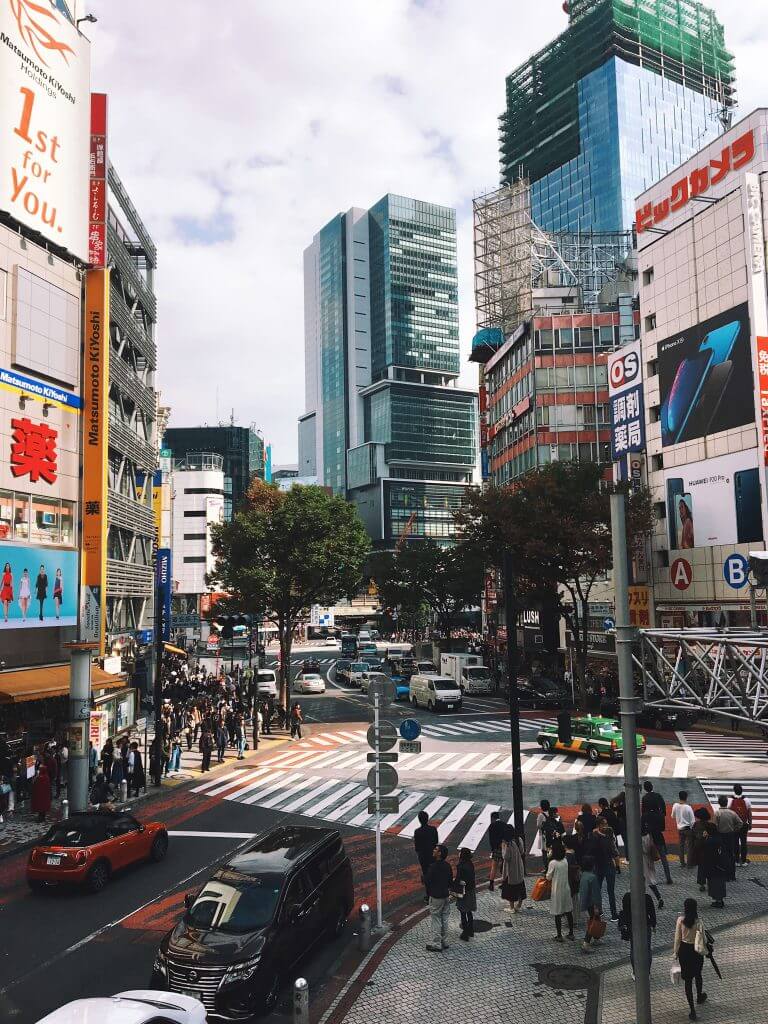
Spending two weeks in Japan is the perfect amount of time when you’re visiting for the first time. It’s exactly how long I spent in Japan during my very first trip. After having returned to Japan multiple times since then, I’ve perfected this itinerary to help you avoid any mistakes I’ve made.
This itinerary loosely follows the famous Golden Route, along with some personal alterations I think are 100% worth it. If you follow this guide, it will take you to Tokyo (3 days), Mount Fuji (1 day), Hakone, Nikko or Kamakura (2 days), Kyoto (3 days), Osaka (1 day), Nara (1 day), Himeji (1 day), Hiroshima (1 day) and Miyajima (1 day).
While there are quite a few places included in this itinerary, you don’t have to drag your luggage around every day. In the next section, I recommend the cities you should book your hotels in (including some of my favourite hotels and areas). Since you can visit most of the locations on a day trip, you only have to change hotels a couple of times.
Two weeks give you a great first impression of this beautiful country without having to rush. Below, you can find a map of the points of interest in this itinerary – if you download Google Maps, you can even use the interactive map during your trip to not miss out on anything mentioned in this guide.
Along with all the highlights mentioned in this itinerary, the Google Maps below includes some of my favourite photo spots, coffee shops, restaurants and stores to check out during your trip.
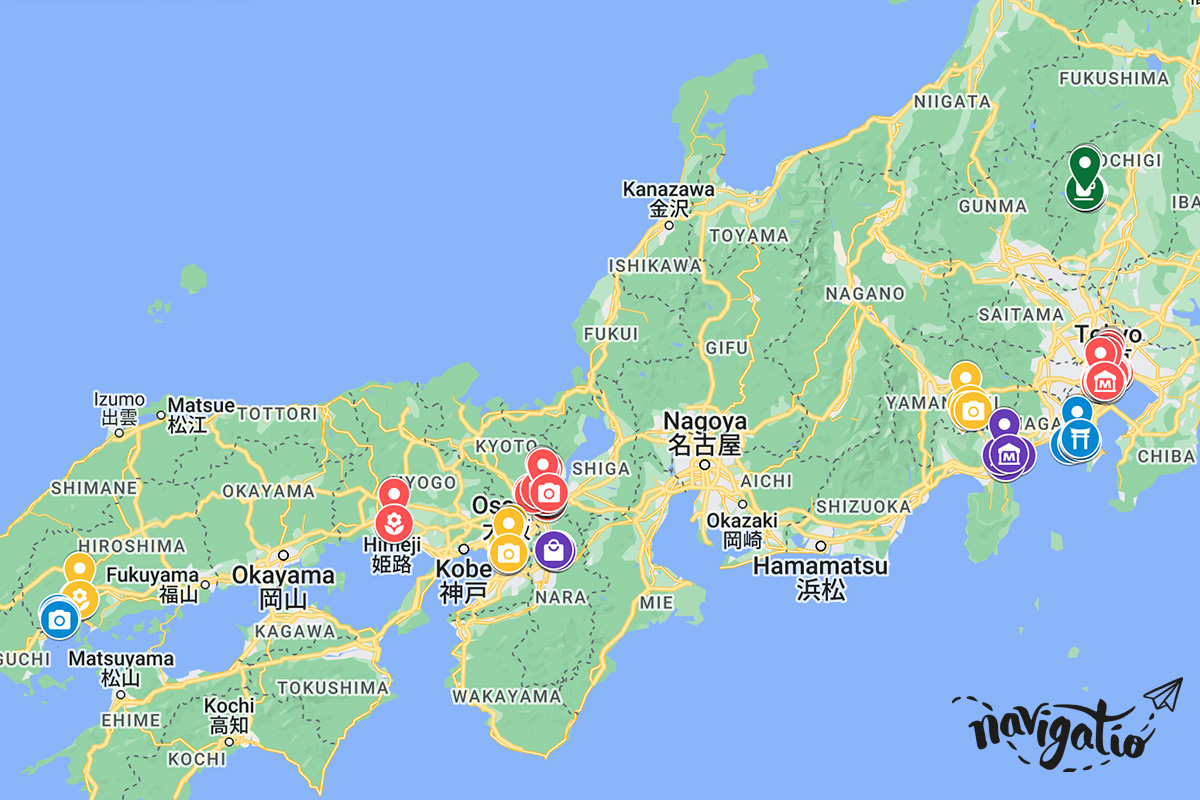
Click here for the interactive Google Maps
To avoid having to drag your luggage around every single day during your two weeks in Japan, it’s best to book a few “home” bases and take day trips from there. Public transport in Japan is very reliable and easy to use, so let’s make the most of it.
On top of that, the locations in this itinerary are very well connected – I’ll highlight any discount passes for public transport you can buy to make your day trips even easier to navigate.
To make the most of your holiday to Japan, I recommend booking accommodation in the following places for the set days:

If you want some more ideas for your itinerary, check out the following guides:
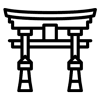
Stay connected to the internet during your trip to Japan (essential for using Google Maps & Translate!) with a Pocket WiFi. Use code THENAVIGATIO15 for 15% off Ninja WiFi Pocket WiFi.
Here is my two week Japan itinerary – feel free to copy it completely or make any changes to match your travel style:
We start our Japan itinerary in the capital city: Tokyo. Most international travellers arrive at one of Tokyo’s two airports – Haneda or Narita. This makes it a great place to start your Japan trip.
From both airports, you can take public transport, hire an airport transfer or get a taxi. Even though it may seem a bit intimidating, using public transport is probably your best bet. It’s much cheaper and really not that difficult!
It’s a good idea to pick up a Suica or Pasmo card at the airport train station (or add it to your iPhone as it’s one of the best Japan travel apps out there). These passes are pre-paid e-money cards that let you use public transport all across Japan. They’re essential for travelling around in the big cities.
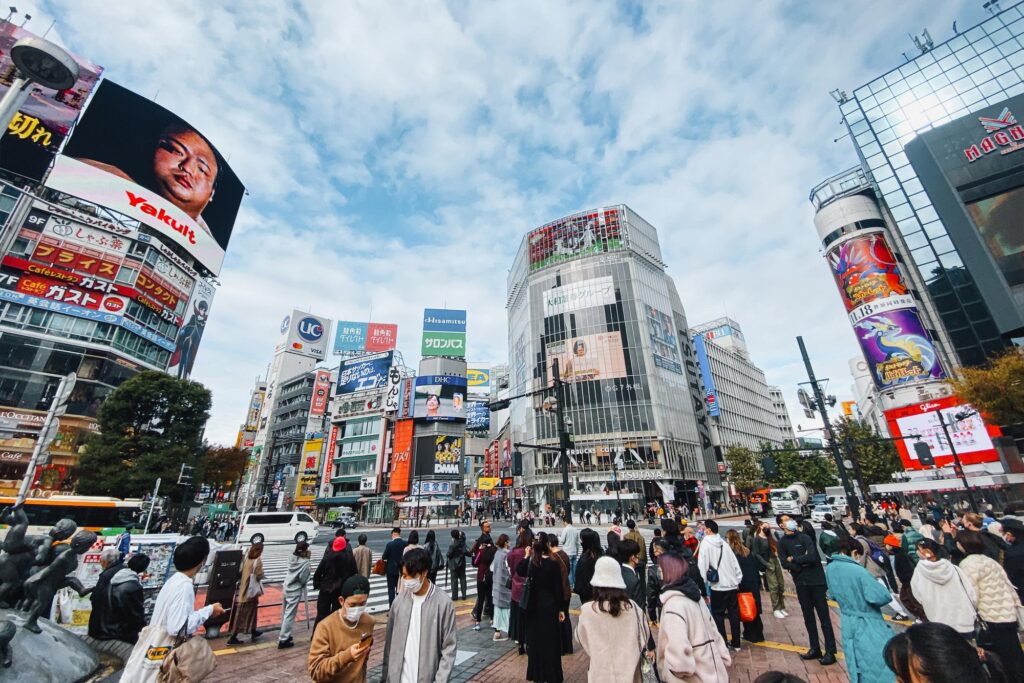
Since the first six days of this trip are in and around Tokyo, it’s best to book your hotel in Tokyo for the first six days. To avoid having to carry suitcases around, it’s much easier to stay in the same hotel – you can then bring a backpack on any day trips you plan to take.
As Tokyo is one of the largest and busiest cities in the world, it may be a little overwhelming to choose where to stay. For first-time visitors, Minato, Asakusa or Roppongi are good choices.
Our guide on where to stay in Tokyo includes an even more in-depth breakdown for different types of travellers, but here are my recommendations for first-time visitors:
Tokyo is such a big city, you could easily spend a month here and not get bored. But since we want to make the most of our two weeks in Japan, I planned the following three days in Tokyo for you.
The start of this itinerary gives you a great first impression of Tokyo, allowing you to explore most of the main highlights of this beautiful city! Here is what I recommend you to do on the first day in Tokyo:
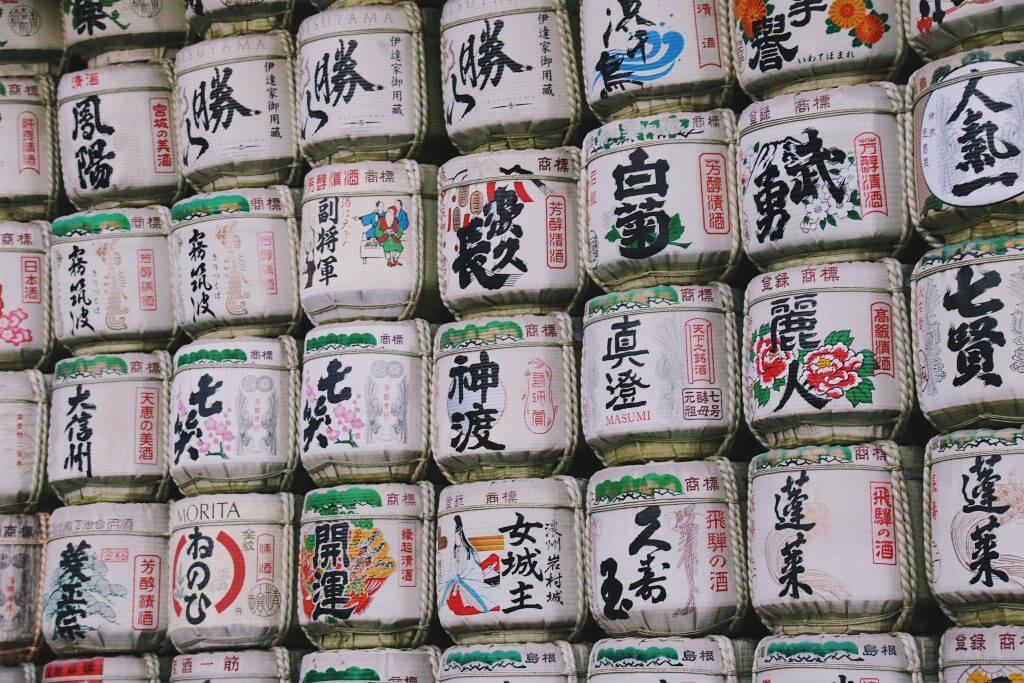


On our second day in Tokyo, we visit Asakusa, Ueno and Akihabara. It’s quite a contrast going from one of the most traditional parts of Tokyo (Asakusa) to a part that literally goes by the nickname “Electric Town“, but it gives you a chance to see quite a few of Tokyo’s main sights:
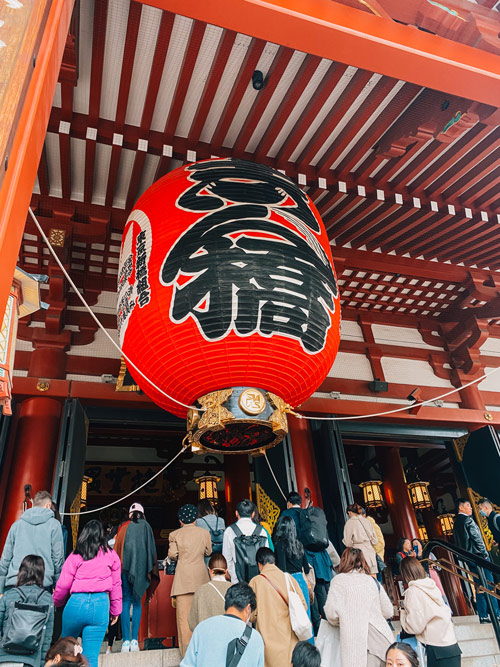
Senso-ji Temple

O-mikuji
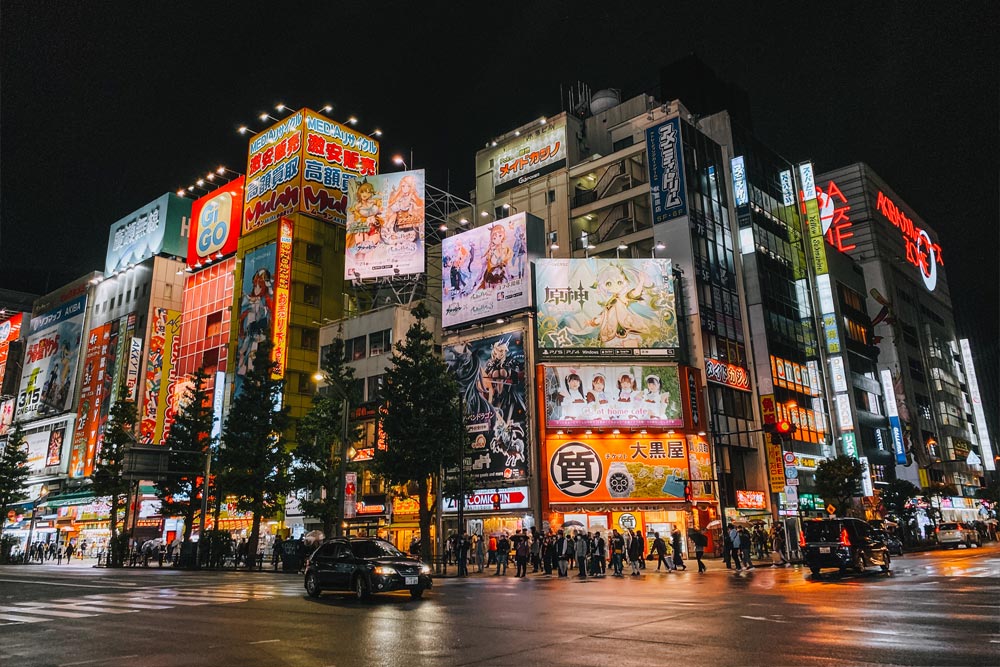
Akihabara at night
As we arrive at our last day in Japan’s capital city, we tick off a few more highlights before we start venturing outside of Tokyo. Here is what I recommend you to check out on your third day in Japan:
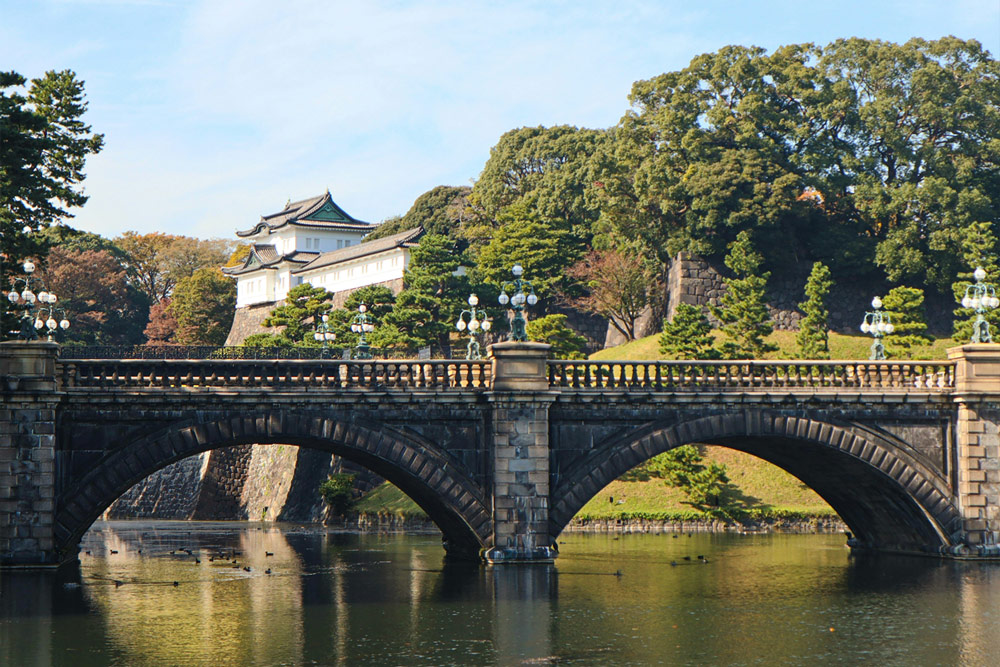

If there’s one thing Japan is famous for, it’s the majestic Mount Fuji. And no trip to Japan is complete without paying a visit to this sacred volcano.
It’s possible to climb Mount Fuji during hiking season (July to September), but beware that this can take up to 10 hours to complete. For a day trip to Mount Fuji from Tokyo, it’s much better to enjoy the surrounding areas of Mount Fuji and take in the views.
The best way to see Mount Fuji is by taking a bus or train to Lake Kawaguchiko. From there, you can explore the area further. I’ve added some of the best photo spots to capture Mount Fuji to the Google Maps for this itinerary.
Alternatively, you can book a fully guided day tour from Tokyo. While it’s cheaper to DIY a trip to Mount Fuji, with a guided tour, you’ll be sure to see all the main points of interest.

Mount Fuji tends to hide in the clouds quite often! Since it’s tricky to plan a clear day ahead of schedule, you may want to keep an eye on the weather when you’re IN Japan and swap some of the days around when staying in Tokyo.
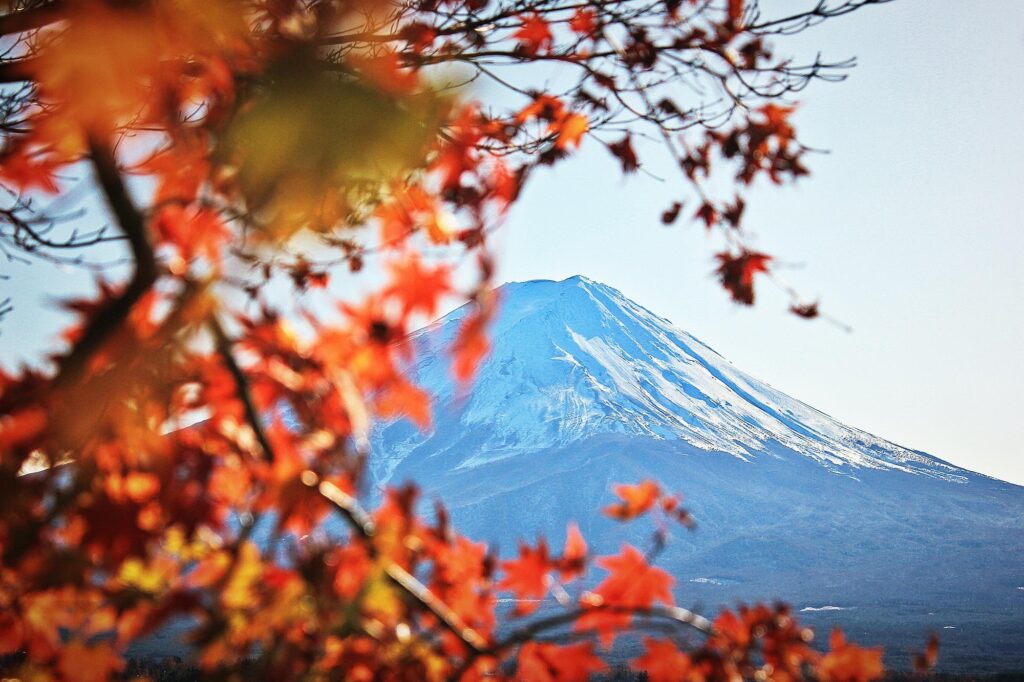
During the next two days in this Japan itinerary, you have some choices. There is a lot to explore near Tokyo, so I wanted to give you the opportunity to pick two day trip destinations that match your interests best.
Some of the best day trips from Tokyo include Kamakura, Hakone and Nikko. Below, I’ve broken down the best things to do when taking a day trip to all three of them. Have a read-through and see which ones stick out to you best so you can add them to your own itinerary.
Hakone is a personal favourite of mine. Not only is it home to incredible views of Mount Fuji, some of the best onsens in Japan and beautiful shrines, but I also got engaged here to the love of my life!
From Tokyo, it takes around 1–1.5 hours to get to Hakone. This makes it a great day trip from the busy metropolitan city – and a chance to see a different side of Japan.
When taking a day trip from Tokyo, you should look into getting the Hakone Free Pass. This discount pass includes a return journey from Shinjuku to Hakone, free public transport in the Hakone area (including the pirate ship and ropeway) and multiple discounts. It’s a money AND time saver, win-win!
When taking a day trip to Hakone, here are some of the best things to do:
For a more detailed breakdown and travel route, check my one day Hakone itinerary.
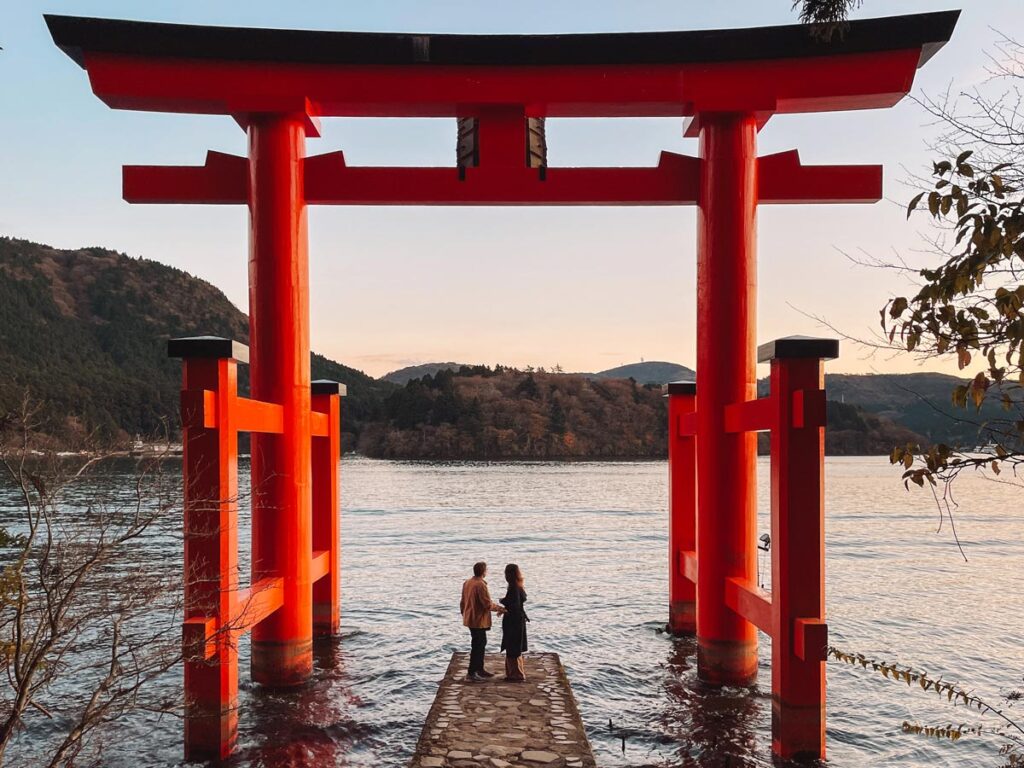
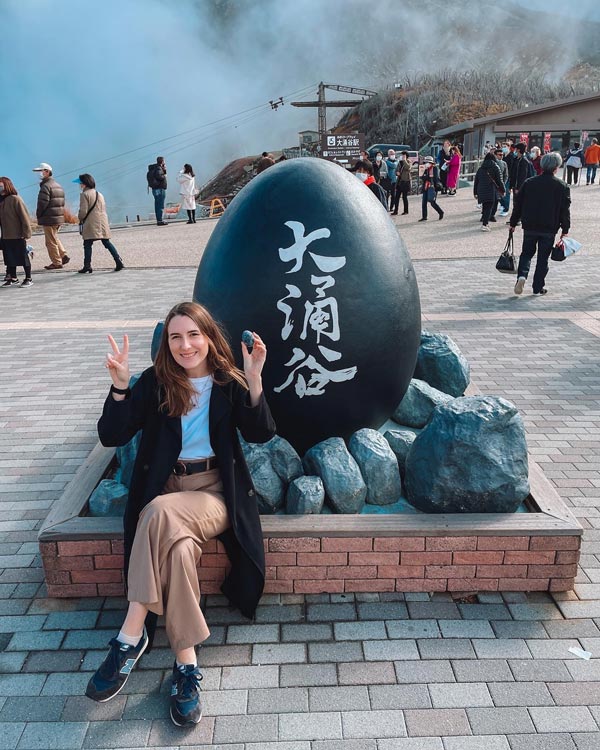
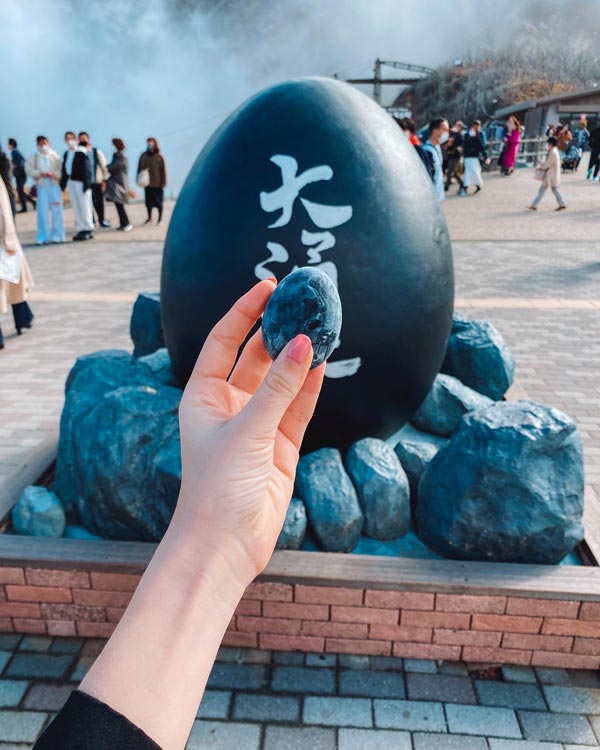

Hakone is also a great place to stay overnight, as it’s home to many Japanese hot spring hotels. Our guide on where to stay in Hakone has some of the best ones (including hotels with Mount Fuji views!).
Nikko is a little bit further from Tokyo compared to Hakone (around 2–3 hours), but it remains one of the best trips to take from the capital. This mountain town is filled with history and is surrounded by beautiful nature.
If you’re planning to visit Nikko for the day, it’s worth getting the Nikko World Heritage Area Pass. Similarly to the Hakone Free Pass, this pass includes a return ticket from Tokyo to Nikko and free public transport inside the Nikko area. Since the pass itself is cheaper than a return train ticket, you’ll be saving money.
For your Nikko day trip, you want to check out the following sights:
Check our one day Nikko itinerary for a more detailed breakdown of how to spend the day here.

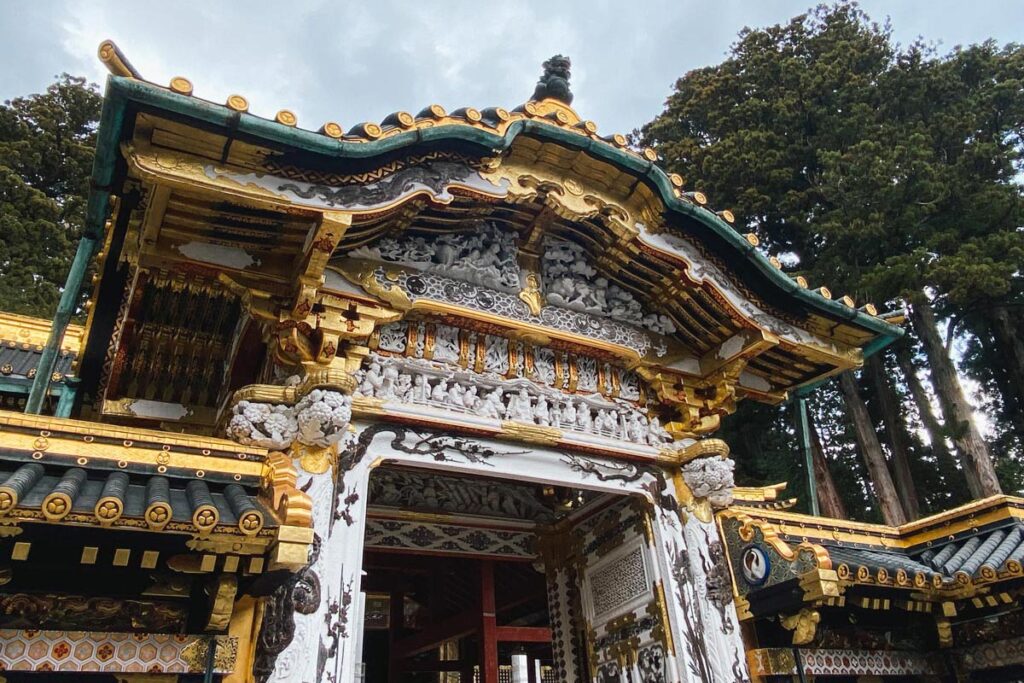

Since it does take a while to get to Nikko, you may want to spend two days here instead of going on another day trip from Tokyo. If you do, check out the best ryokans in Nikko for an unforgettable stay.
Kamakura and Enoshima are two seaside towns near each other, around one hour from Tokyo. They make for a very popular day trip destination – allowing visitors to enjoy the many temples, beaches and hydrangea flowers.
Like Hakone and Nikko, Kamakura and Enoshima have a Freepass that you can use to save money. The Enoshima-Kamakura Freepass includes a return ticket from Shinjuku, unlimited train rides in the area and discounts for participating facilities.
If you’re choosing Kamakura and Enoshima for your day trip, check out the following sights:
Our full Kamakura and Enoshima day trip itinerary includes even more information on what route we suggest you follow.
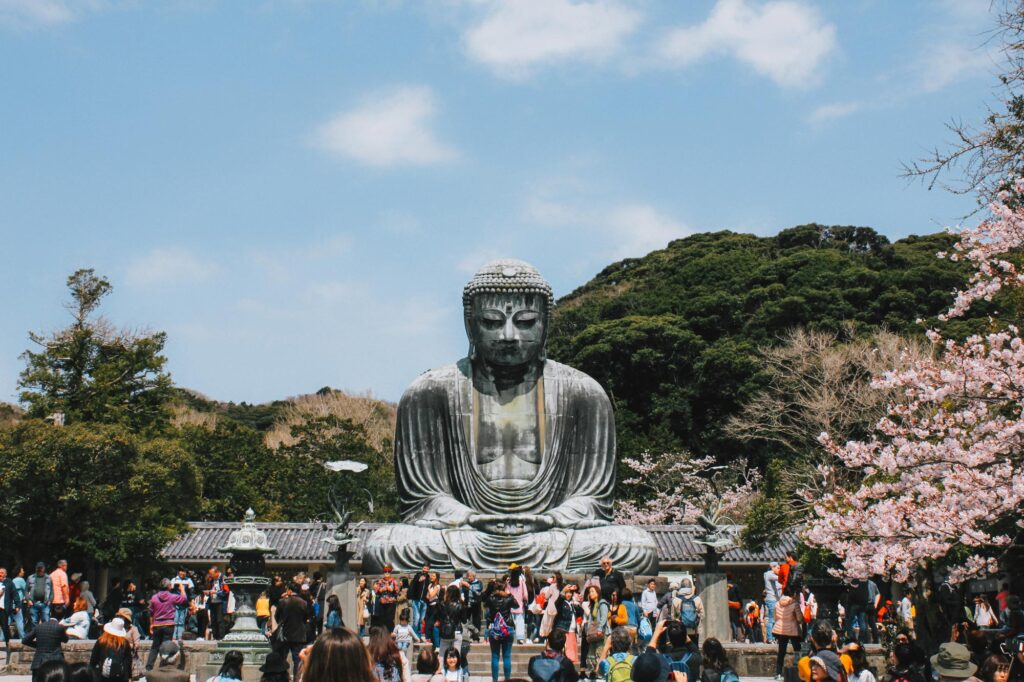
After spending six wonderful days in and around Tokyo, it’s time to head towards Kyoto. Kyoto is known to be the cultural capital of Japan, filled with shrines, temples and old Geisha districts.
For accommodation, you have two options:
The accommodation choices won’t impact the places you’ll visit when following this itinerary. However, staying in Osaka has a completely different atmosphere compared to Kyoto (and it’s often a bit cheaper too), so you may want the best of both worlds. I have a full Kyoto and Osaka comparison so you can decide what’s best for your trip.
Either way, you’ll have to stay in Kyoto for a few nights. We have a full guide on where to stay in Kyoto, but here are my favourite recommendations for first-time visitors:
The easiest and fastest way to get from Tokyo to Kyoto is by riding the Shinkansen, or bullet train. This takes about two hours and 15 minutes.
You can use the JR Pass on this ride. But since the price increase of the Japan Rail Pass in October 2023, it’s not the most cost-effective pass to buy if you’re following this two week Japan itinerary.
It’s cheaper to buy individual tickets for the Shinkansen. You can do so at the train station on the day of your trip. It’s also possible to buy them online in advance if you prefer to have all your tickets pre-booked.
On Day 7 of this itinerary, you can take the Shinkansen from Tokyo to Kyoto. This should take just over two hours, but since the first week of this trip has been pretty full, you may want to take it easy today.
Make sure you get to Kyoto safely and check into your hotel. You can then spend the rest of the day going for a little wander around. I’ve marked a few extra sights on the map that you can check out if you have spare time.
Doing this will still give you two full days to explore Kyoto, which is more than enough time to see some of the city’s best highlights. I have a more detailed 2-day Kyoto itinerary if you want a complete breakdown of the days (including a walking route through the geisha districts). Here is a quick overview of the best things to do in Kyoto:
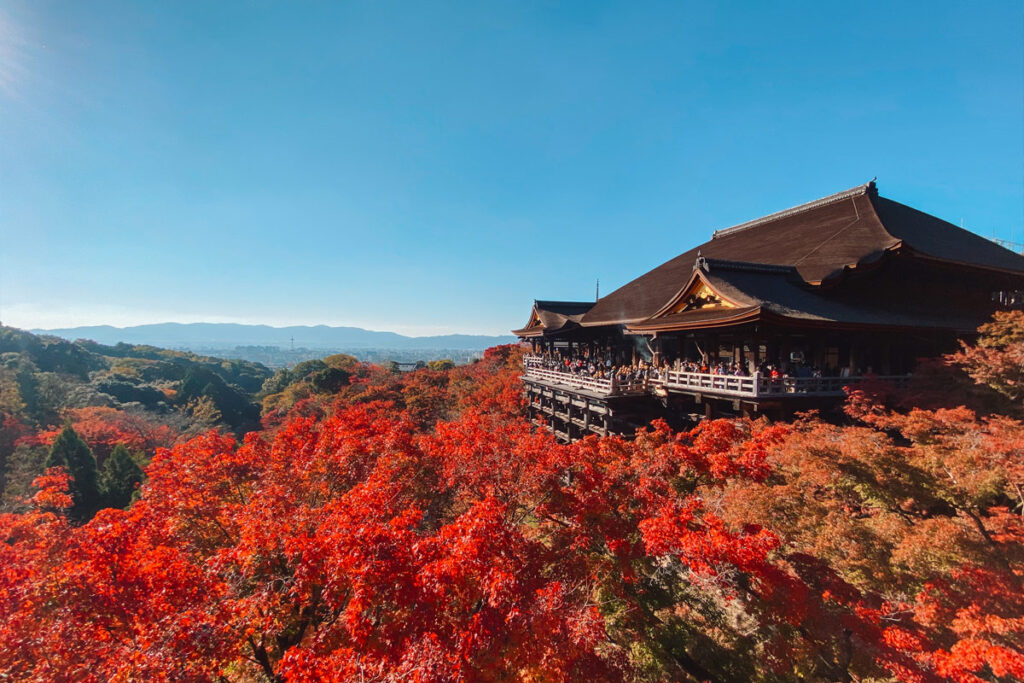

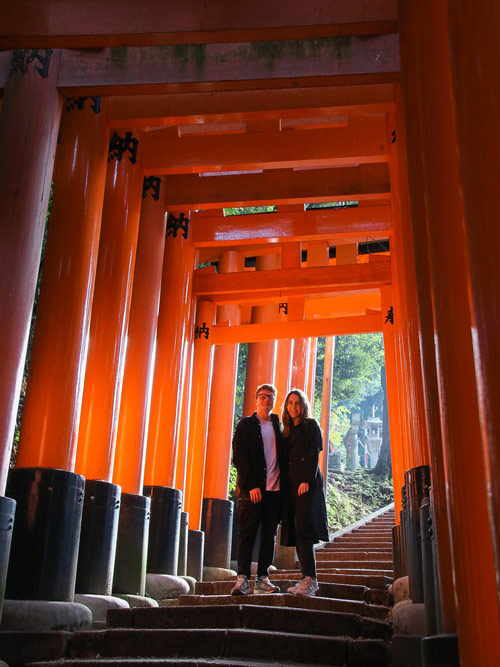
On Day 10, we take a day trip to Osaka. Osaka is known as the kitchen of the nation – with some of the best street food in the whole country. While some people choose to skip Osaka, it’s one of my favourite cities in Japan. The people are so friendly and there are some fantastic sights to see.
From Kyoto, you can get to Osaka within 15 minutes by Shinkansen, or around 30–40 minutes by train. Once you get there, here are some must-see sights:
I have a more detailed one day Osaka itinerary that includes a full breakdown and walking route.
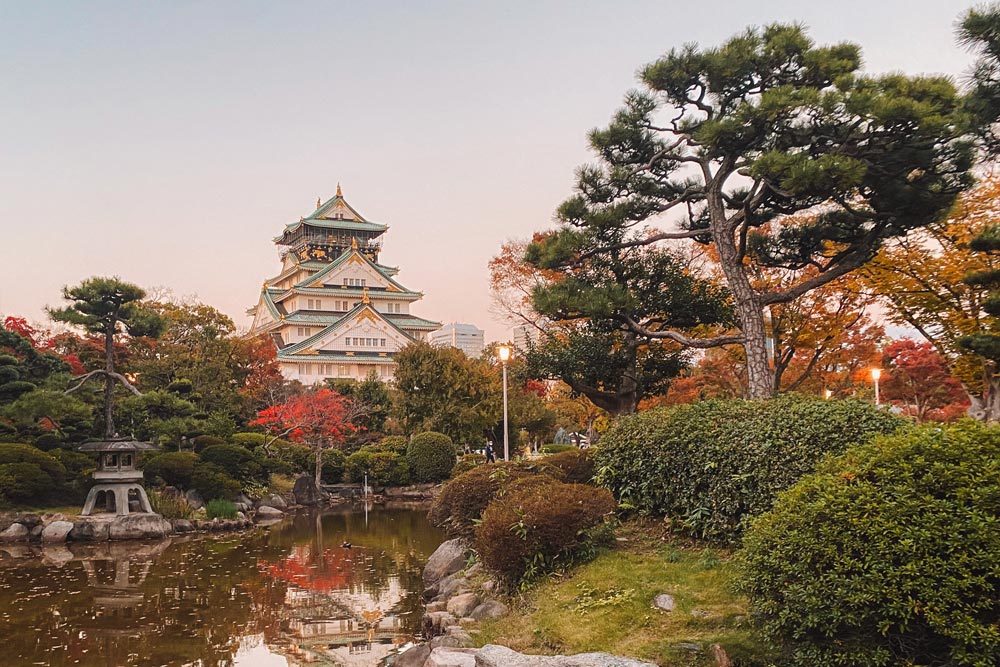

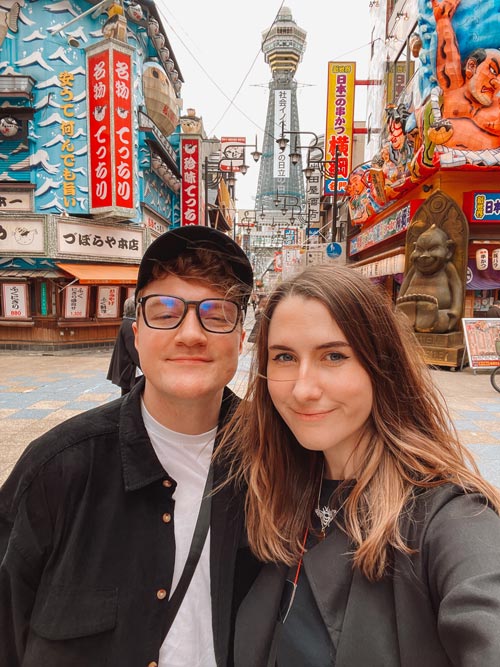
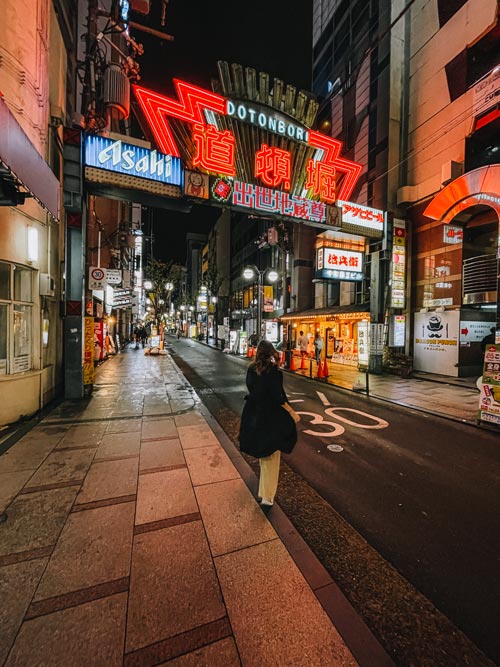
Osaka isn’t far from Kyoto, but because it has a completely different atmosphere you may want to choose to stay here for a couple of nights too. If you’re big on nightlife, for example, Osaka has way more to offer than Kyoto.
My in-depth guide on where to stay in Osaka includes all my favourite areas and hotels in the city, but here’s a quick overview of my top three:
We have a full guide comparing Kyoto and Osaka as bases, so have a read to make sure you know your options.

If you’re planning on visiting Universal Studios Japan (which is located in Osaka), you can choose to replace one of the days in Kyoto, Osaka or Nara as they’re all near each other.
Day 11 is a day trip to Nara. Nara used to be the capital of Japan in the 8th century and its history still shines through today – there are some beautiful shrines and temples.
From Kyoto, you can get to Nara via the JR Nara Line or the Kintetsu Line. It takes between 35–70 minutes. If you’re using the JR Pass, it’s best to look out for the Rapid service, as it’s nearly 25 minutes faster. Without the JR Pass, the Kintetsu Line is a cheaper and faster choice.
From Osaka, you can use the JR Yamatoji Line and the Kintetsu Nara Line to get to Nara. This takes between 35–50 minutes.
When spending a day in Nara, make sure to check out the following sights:
My one day Nara itinerary includes a full walking route you can follow, along with some more information on how to get to Nara from both Osaka and Kyoto.


With the end of our two weeks in Japan coming closer, it’s time to pack up your suitcase again and move towards the last hotel. It’s best to book a hotel in Hiroshima for the remainder of your stay in Japan (or one last night in Osaka or Tokyo, depending on when and where your return flight departs from).
On the way towards Hiroshima, make a stop at Himeji. Known for its beautiful castle, Himeji is the perfect place to add to your two week Japan itinerary as it’s conveniently located on the way to Hiroshima.
You can store your luggage in one of the lockers at the station in Himeji. That way, you won’t have to carry them around all day.
For your day in Himeji, here are some sights to check out:
Our guide on how to spend one day in Himeji has some more information on what to see, how to get there and what route to follow to make the most of your time here.
After some time in Himeji, pick up your suitcases and continue your train journey to Hiroshima. This is where you’ll stay for the next few nights.

Photo by Sabrina Isenberg
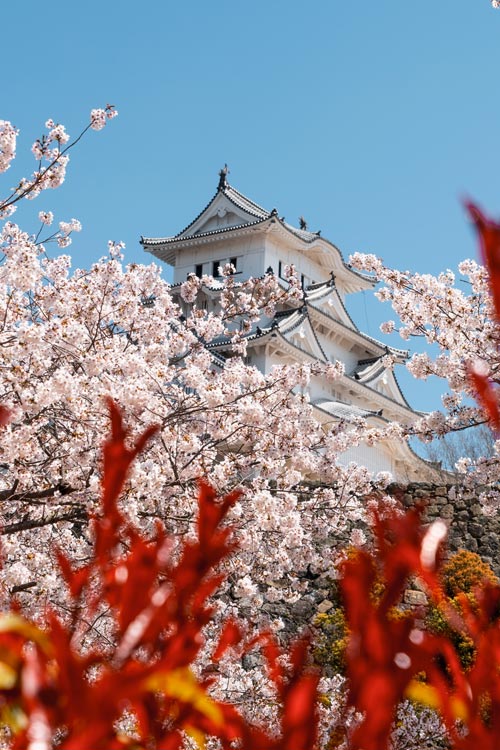
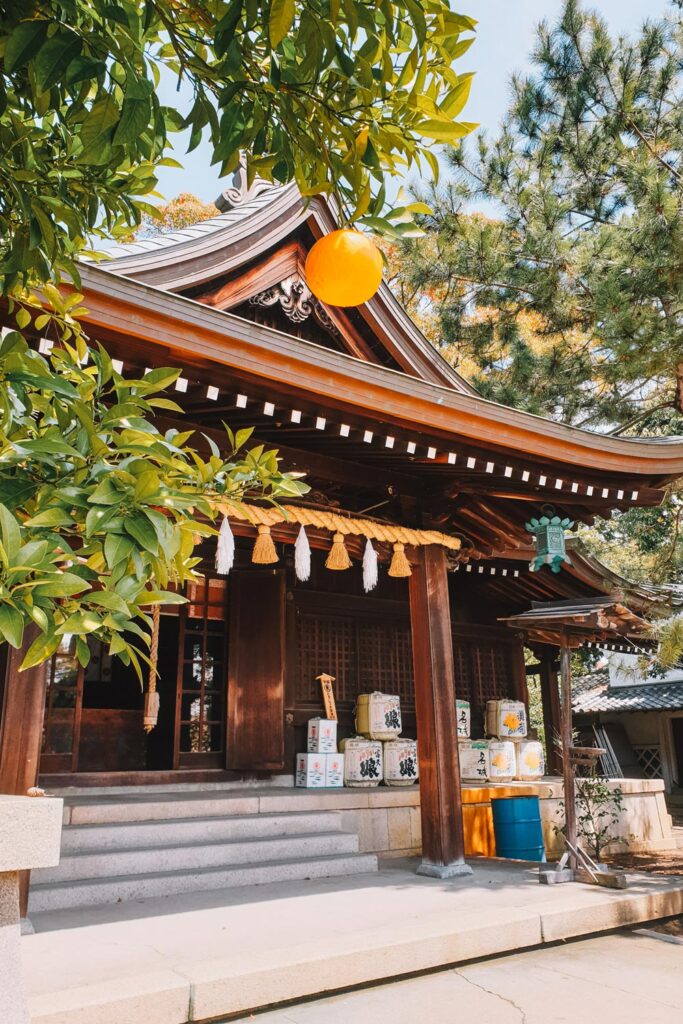
Photo by Sabrina Isenberg
As Hiroshima is your base for your last few days in Japan, today we’re taking some time to explore it. Hiroshima, of course, is mostly known by people through the atomic bombing on August 6, 1945. Luckily, it has rebuilt itself to be a bustling city – one that welcomes hundreds of thousands of tourists every year.
When spending the day here, this is what I recommend you to check out:
Our guide on how to spend a day in Hiroshima has more information to make the most of your time here.
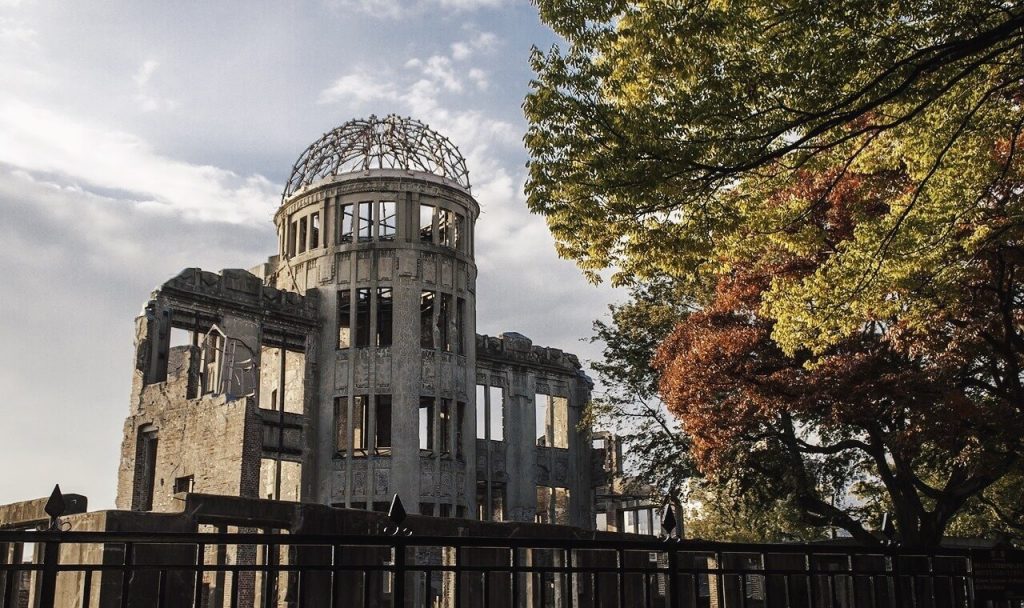

On our last day in Japan, we take a day trip to Miyajima from Hiroshima. From Hiroshima Station, it only takes about 30 minutes to get to Miyajimaguchi Station on the JR Sanyo Line.
Check out our full guide on how to spend one day in Miyajima for more in-depth information.

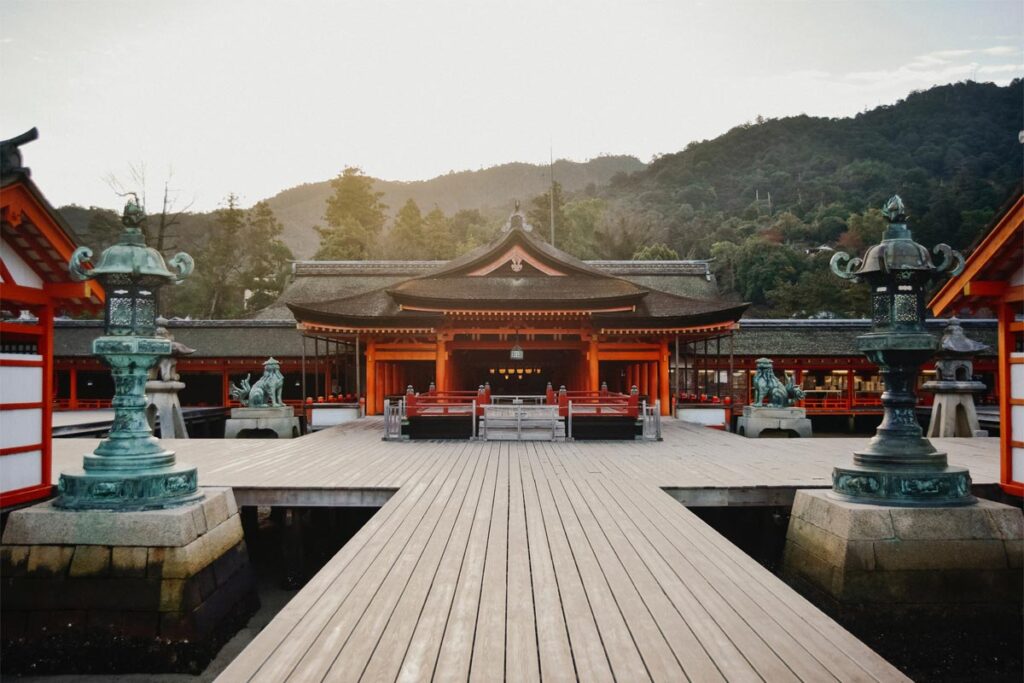
As this is the last stop on our Japan itinerary, you can make your way back to the airport for your return flight.
If you have the option to fly back home from Osaka, that will save you a long journey back to Tokyo (and since the Shinkansen isn’t exactly cheap, you’ll probably save quite a bit of money too). From Hiroshima, it’s about 1.5 hours to Osaka on the Shinkansen, compared to nearly 5 hours to Tokyo.
Two weeks is enough time to see some of Japan’s main highlights. In this two week Japan itinerary, you’ll visit Tokyo, Hakone, Kyoto, Osaka, Nara, Himeji, Hiroshima and Miyajima – it’s the perfect amount of time when you’re visiting Japan for the first time.
If you’d like to spend more time in Japan, please check out my 3 week Japan itinerary. However, if you only have two weeks, it’s still more than enough to get a perfect first impression of Japan. Don’t be alarmed if you’ll be looking at flights back to Japan as soon as you return home though!
No, for this two week Japan itinerary, you don’t need a JR Pass. It’s cheaper to buy individual tickets for the Shinkansen and use a Suica/Pasmo card for travel inside the cities.
Up until October 2023, the JR Pass was a great way to save money on a trip like the one in this guide. However, the prices of the pass have increased by nearly 70% in October 2023, making it hard to keep recommending them.
Since this itinerary is spread over two weeks, and you won’t be using the Shinkansen too often, buying individual tickets is a cheaper option.
You can buy tickets for the Shinkansen at the station on the day of your trip. Just use the ticket machine or head to the JR office to get help from a member of staff. If you’re travelling with suitcases, make sure to let someone know so they can seat you somewhere with storage.
If you prefer pre-booking your tickets, you can do so on Klook.
You can make your trip to Japan as cheap or as expensive as you’d like. To give you a bit of guidance, we spent around £2,100 per person for this two week trip. This includes flights, hotels, food, souvenirs, all activities and any extras. I have a full breakdown of the cost of going to Japan on my blog too.
However, since flights and the JR Pass have increased significantly in price, it’s better to budget around £2,500 per person for a two week mid-range Japan trip.
And that concludes my recommended two-week Japan itinerary. While there is so much more to see and do in Japan, this itinerary gives you a great first impression of what Japan is all about. Don’t be surprised if you’re leaving after two weeks wanting more – that’s how I started my own Japan obsession!
If you have a little more time to visit Japan (or want some other ideas of what to include in your itinerary), my 3 week Japan itinerary includes some more places to explore. Alternatively, you can continue travelling to Fukuoka from Hiroshima and add a week in Kyushu to your Japan travel plans.
But for now – happy travel planning and I hope you have the most amazing time in Japan!
As you can probably tell from my travel blog, Japan is my all-time favourite destination. Ever since I was 13 years old, it was my dream to visit it. When I was finally able to visit it, 10 years later, it turned out to be even better than expected.
After my first trip to Japan, it was only a matter of time before I returned. And again. And again. Planning that first trip, however, was a little stressful. I wanted to make the most out of it because I had no idea if (or when) I would get this chance again.
Are you in the same boat? Do not worry, I’ve got you covered! I crafted this two-week Japan itinerary for those who are visiting Japan for the first time and want to make the most of their time there.
Let’s dive in.
In This Travel Guide
- Two Weeks in Japan Overview & Map
- Two Week Japan Itinerary

Two Weeks in Japan Overview & Map
Spending two weeks in Japan is the perfect amount of time when you’re visiting for the first time. It’s exactly how long I spent in Japan during my very first trip. After having returned to Japan multiple times since then, I’ve perfected this itinerary to help you avoid any mistakes I’ve made.
This itinerary loosely follows the famous Golden Route, along with some personal alterations I think are 100% worth it. If you follow this guide, it will take you to Tokyo (3 days), Mount Fuji (1 day), Hakone, Nikko or Kamakura (2 days), Kyoto (3 days), Osaka (1 day), Nara (1 day), Himeji (1 day), Hiroshima (1 day) and Miyajima (1 day).
While there are quite a few places included in this itinerary, you don’t have to drag your luggage around every day. In the next section, I recommend the cities you should book your hotels in (including some of my favourite hotels and areas). Since you can visit most of the locations on a day trip, you only have to change hotels a couple of times.
Two weeks give you a great first impression of this beautiful country without having to rush. Below, you can find a map of the points of interest in this itinerary – if you download Google Maps, you can even use the interactive map during your trip to not miss out on anything mentioned in this guide.
Along with all the highlights mentioned in this itinerary, the Google Maps below includes some of my favourite photo spots, coffee shops, restaurants and stores to check out during your trip.

Click here for the interactive Google Maps
Where to Stay in Japan for Two Weeks
To avoid having to drag your luggage around every single day during your two weeks in Japan, it’s best to book a few “home” bases and take day trips from there. Public transport in Japan is very reliable and easy to use, so let’s make the most of it.
On top of that, the locations in this itinerary are very well connected – I’ll highlight any discount passes for public transport you can buy to make your day trips even easier to navigate.
To make the most of your holiday to Japan, I recommend booking accommodation in the following places for the set days:
| Days | City | Recommended Hotel/Area |
|---|---|---|
| 1–6 | Tokyo | Where to stay in Tokyo (full guide) |
| 7–11 | Kyoto | Where to stay in Kyoto (full guide) |
| 12–14 | Hiroshima | Where to stay in Hiroshima (guide will be published soon) |

Looking for More Japan Guides?
If you want some more ideas for your itinerary, check out the following guides:
- Are two weeks in Japan not enough for you? Check out my 3 week Japan itinerary to add another week to your trip.
- If two weeks is a bit too long, my 10 day Japan itinerary gives you a compressed version of this two week Japan itinerary.
- Want to see a more unique side of Japan? Our 7-day Kyushu itinerary shows you a whole different side of Japan.
- And what about the costs? I’ve broken down the cost of this two-week trip to Japan – it includes everything from flights to souvenirs, down to the penny!

Stay connected to the internet during your trip to Japan (essential for using Google Maps & Translate!) with a Pocket WiFi. Use code THENAVIGATIO15 for 15% off Ninja WiFi Pocket WiFi.
Two Week Japan Itinerary
Here is my two week Japan itinerary – feel free to copy it completely or make any changes to match your travel style:
Tokyo (Day 1 – 3)
We start our Japan itinerary in the capital city: Tokyo. Most international travellers arrive at one of Tokyo’s two airports – Haneda or Narita. This makes it a great place to start your Japan trip.
From both airports, you can take public transport, hire an airport transfer or get a taxi. Even though it may seem a bit intimidating, using public transport is probably your best bet. It’s much cheaper and really not that difficult!
It’s a good idea to pick up a Suica or Pasmo card at the airport train station (or add it to your iPhone as it’s one of the best Japan travel apps out there). These passes are pre-paid e-money cards that let you use public transport all across Japan. They’re essential for travelling around in the big cities.

Since the first six days of this trip are in and around Tokyo, it’s best to book your hotel in Tokyo for the first six days. To avoid having to carry suitcases around, it’s much easier to stay in the same hotel – you can then bring a backpack on any day trips you plan to take.
As Tokyo is one of the largest and busiest cities in the world, it may be a little overwhelming to choose where to stay. For first-time visitors, Minato, Asakusa or Roppongi are good choices.
Our guide on where to stay in Tokyo includes an even more in-depth breakdown for different types of travellers, but here are my recommendations for first-time visitors:
| Area | Best For | Hotel | Book Now |
| Minato | First-time visitors | Park Hotel Tokyo | Check Availability |
| Asakusa | Budget travellers | Hotel Sunroute Asakusa | Check Availability |
| Roppongi | Luxury | The Prince Park Tower Tokyo | Check Availability |
Day 1 – Tokyo
Tokyo is such a big city, you could easily spend a month here and not get bored. But since we want to make the most of our two weeks in Japan, I planned the following three days in Tokyo for you.
The start of this itinerary gives you a great first impression of Tokyo, allowing you to explore most of the main highlights of this beautiful city! Here is what I recommend you to do on the first day in Tokyo:
- Visit Meiji Shrine: This beautiful shrine can be found in one of the biggest parks in Tokyo. A giant wooden torii gate welcomes you near Harajuku Station, guiding you through a forest of over 100,000 trees towards the shrine. You can also find the iconic wall of over 200 traditional sake barrels here.
- Shop in Harajuku: Near Meiji Shrine lays Takeshita Street, one of Harajuku’s most popular shopping streets. Keep walking to get to Omotesando for even more stores – you may even see some people dressed up in Harajuku-style fashion.
- Try Purikura: Unlike the basic photo boots you find in the West that you can use to take plain passport pictures, Japan has Purikura! These kawaii photo boots let you take pictures with cute filters – afterwards, you can edit them and add stickers, text and more. The photos are printed and you can take them home as the perfect Japan keepsake.
- Walk across Shibuya Crossing: Shibuya is only a short metro ride (or 15-minute walk) from Harajuku and is home to the famous Shibuya Crossing. Named the busiest crossing in the world, it’s a popular sight to visit in Tokyo. Visit L’Occitane Cafe, Cé La Vi or the Starbucks (temporarily closed for renovation) for a drink and a view over this iconic spot.
- Hachiko Statue: Just outside of Shibuya Station, you can find Hachiko Statue. This famous dog was given a statue after he waited for his owner to return to Shibuya station for years.
- Enjoy Tokyo from above at Shibuya Sky: For one of the best views in Tokyo, head over to Shibuya Sky. This 360-degree open-air observation deck is quite popular so make sure you book tickets in advance (around 30 minutes before sunset is the best time to go, in my opinion). On a clear day, you can even see Mount Fuji in the distance.
- Get food and drinks in Shibuya Centre Gai: Exploring Shibuya Centre Gai is one of the best things to do in Tokyo at night. This narrow street in Shibuya is a popular place for people to shop, eat and drink. Head over here after enjoying the views from Shibuya Sky – just in time to grab some dinner and even a drink or two at one of the many izakayas.



Day 2 – Tokyo
On our second day in Tokyo, we visit Asakusa, Ueno and Akihabara. It’s quite a contrast going from one of the most traditional parts of Tokyo (Asakusa) to a part that literally goes by the nickname “Electric Town“, but it gives you a chance to see quite a few of Tokyo’s main sights:
- Explore Senso-ji Temple: Senso-ji Temple is the oldest temple in Tokyo, dating back to the year 645. The temple grounds are covered with the most beautiful buildings and gardens, making it one of the best landmarks in Japan.
- Try o-mikuji: This Japanese form of fortune-telling can often be done at temples in Japan, and Senso-ji is no exception. It’s very simple: you pay 100 yen and shake the wooden box until a stick falls out. The stick has a number written on it. The number will correspond with your fortune, from “very fortunate” to “a great curse”.
- Shop on Nakamise Street: Just outside the main temple, you can find Nakamise Street. This 200-meter-long street is filled with independent vendors selling souvenirs and snacks.
- Visit Ueno Park: Ueno Park is one of the best places in Tokyo to enjoy cherry blossoms. If you’re visiting Japan in late March or early April, make sure to add this to your itinerary. But even outside of cherry blossom season, you can find some great museums here.
- Have lunch or shop in Ueno Ameyoko: This lively, open-air market is perfect for some shopping or a quick lunch. The atmosphere is amazing and definitely worth a visit while you’re in the area.
- Explore Akihabara: Also known as “Electric Town”, Akihabara is the place for any anime or video game fan. It’s filled with stores selling retro video games, anime figures and more. If you’re a pop-culture fan, make sure to spend some time exploring this area (and have enough room in your suitcase!). I highlighted my favourite retro game shops on the interactive map for this guide.
- Play in the arcades: Akihabara is also home to countless arcades. Japan has its fair share of arcades, and they’re super fun to try yourself. Make sure to go beyond the first floor though. The crane machines, which you can normally find on the first floor, are fun, but the better (less cash-gabby) games are found upstairs.

Senso-ji Temple

O-mikuji

Akihabara at night
Day 3 – Tokyo
As we arrive at our last day in Japan’s capital city, we tick off a few more highlights before we start venturing outside of Tokyo. Here is what I recommend you to check out on your third day in Japan:
- Visit Tokyo Imperial Palace: Tokyo became Japan’s capital in 1868, when the Emperor moved to Tokyo. The current Imperial Palace is built on the grounds of Edo Castle – a must-visit when in Tokyo. When visiting, a guided tour is recommended, as you can’t access some of the grounds without one.
- Explore the Zōjō-ji Temple grounds: While heading towards Tokyo Tower, the next stop on this itinerary, make a quick stop at Zōjō-ji Temple. It’s a beautiful temple with great views of Tokyo Tower.
- Snap a picture of Tokyo Tower: One of the most iconic landmarks in Tokyo has to be Tokyo Tower. While I don’t recommend paying to go all the way to the top (there are much better views in Roppongi, where you can actually see Tokyo Tower as part of the skyline!), there are some great photo spots nearby.
- Visit one of Roppongi’s museums/art galleries: Roppongi is home to many art galleries and museums. The famous Roppongi Art Triangle includes three of the best ones: Mori Art Museum, the National Art Gallery and the Suntory Museum of Art. If you only have time for one, I’d suggest checking out Mori Art Museum as you’ll also be treated to one of the best views of Tokyo Tower here. 21 21 Design Sight is another museum to check out – it focuses on Japanese modern design.
- Try Karaoke: After dinner, you can check out one of the many karaoke parlours in this area of Tokyo. Karaoke in Japan is a bit different from what you’re probably used to, as you can rent an individual booth to sing songs – plus, you can order drinks to your booth.


Mount Fuji (Day 4)
If there’s one thing Japan is famous for, it’s the majestic Mount Fuji. And no trip to Japan is complete without paying a visit to this sacred volcano.
It’s possible to climb Mount Fuji during hiking season (July to September), but beware that this can take up to 10 hours to complete. For a day trip to Mount Fuji from Tokyo, it’s much better to enjoy the surrounding areas of Mount Fuji and take in the views.
The best way to see Mount Fuji is by taking a bus or train to Lake Kawaguchiko. From there, you can explore the area further. I’ve added some of the best photo spots to capture Mount Fuji to the Google Maps for this itinerary.
Alternatively, you can book a fully guided day tour from Tokyo. While it’s cheaper to DIY a trip to Mount Fuji, with a guided tour, you’ll be sure to see all the main points of interest.

Mount Fuji tends to hide in the clouds quite often! Since it’s tricky to plan a clear day ahead of schedule, you may want to keep an eye on the weather when you’re IN Japan and swap some of the days around when staying in Tokyo.

Hakone, Nikko or Kamakura (Day 5 – 6)
During the next two days in this Japan itinerary, you have some choices. There is a lot to explore near Tokyo, so I wanted to give you the opportunity to pick two day trip destinations that match your interests best.
Some of the best day trips from Tokyo include Kamakura, Hakone and Nikko. Below, I’ve broken down the best things to do when taking a day trip to all three of them. Have a read-through and see which ones stick out to you best so you can add them to your own itinerary.
Hakone Day Trip
Hakone is a personal favourite of mine. Not only is it home to incredible views of Mount Fuji, some of the best onsens in Japan and beautiful shrines, but I also got engaged here to the love of my life!
From Tokyo, it takes around 1–1.5 hours to get to Hakone. This makes it a great day trip from the busy metropolitan city – and a chance to see a different side of Japan.
When taking a day trip from Tokyo, you should look into getting the Hakone Free Pass. This discount pass includes a return journey from Shinjuku to Hakone, free public transport in the Hakone area (including the pirate ship and ropeway) and multiple discounts. It’s a money AND time saver, win-win!
When taking a day trip to Hakone, here are some of the best things to do:
- Soak in an onsen: Onsens are Japanese hot springs and Hakone is one of the best hot spring towns in Japan. Do keep in mind that most onsens require you to bathe naked and separate men and women.
- Hakone Shrine: One of the must-visit places in Hakone is the shrine that shares the town’s name. This beautiful shrine has a huge torii gate looking out over Lake Ashi. There is usually a bit of a waiting time for taking photos though – I waited around 30 minutes for mine.
- Visit Owakudani (Boiling Valley): From Hakone, you can take a gondola up the mountain near the town. At the top, you can find Owakundani, also known as the Boiling Valley. The volcano erupted 3,000 years ago, but the impact is still very much noticeable.
- Eat a black egg: When visiting Owakundani, make your way to the volcanic zone and eat a black egg. The eggs are boiled in the volcanic water and the minerals inside give the egg its black colour. It’s totally safe to eat and legend says eating one will prolong your life by seven years – worth a shot
.
For a more detailed breakdown and travel route, check my one day Hakone itinerary.




Hakone is also a great place to stay overnight, as it’s home to many Japanese hot spring hotels. Our guide on where to stay in Hakone has some of the best ones (including hotels with Mount Fuji views!).
Nikko Day Trip
Nikko is a little bit further from Tokyo compared to Hakone (around 2–3 hours), but it remains one of the best trips to take from the capital. This mountain town is filled with history and is surrounded by beautiful nature.
If you’re planning to visit Nikko for the day, it’s worth getting the Nikko World Heritage Area Pass. Similarly to the Hakone Free Pass, this pass includes a return ticket from Tokyo to Nikko and free public transport inside the Nikko area. Since the pass itself is cheaper than a return train ticket, you’ll be saving money.
For your Nikko day trip, you want to check out the following sights:
- Shinkyo Bridge: From the train station, it takes about 5 minutes by bus to get to Shinkyo Bridge. This nearly 400-year-old bridge is the gateway to the majority of shrines and temples you can find in Nikko and a perfect place to start your day.
- Rinnoji Temple: This temple was founded in the 8th century by a Buddhist monk who brought Buddhism to the city. Nowadays, Tendai monks train in this UNESCO World Heritage site.
- Toshogu Temple: This is by far Nikko’s most notable temple. Toshogu Temple is the last resting place of Tokugawa Ieyasu. The temple is beautifully decorated and is a real treat to visit.
- Kanmangafuchi Abyss: Many years ago, Mount Nantai erupted and created this valley. Here, you can find 74 statues wearing red crocheted hats and bibs. Legend says the number of statues changes every time you count them.
Check our one day Nikko itinerary for a more detailed breakdown of how to spend the day here.



Since it does take a while to get to Nikko, you may want to spend two days here instead of going on another day trip from Tokyo. If you do, check out the best ryokans in Nikko for an unforgettable stay.
Kamakura & Enoshima Day Trip
Kamakura and Enoshima are two seaside towns near each other, around one hour from Tokyo. They make for a very popular day trip destination – allowing visitors to enjoy the many temples, beaches and hydrangea flowers.
Like Hakone and Nikko, Kamakura and Enoshima have a Freepass that you can use to save money. The Enoshima-Kamakura Freepass includes a return ticket from Shinjuku, unlimited train rides in the area and discounts for participating facilities.
If you’re choosing Kamakura and Enoshima for your day trip, check out the following sights:
- Explore Enoshima: Enoshima is a small island near Kamakura. Give yourself 2–3 hours in the morning to explore it, including Enoshima-jinja, Samuel Cocking Garden and Nakamise Street.
- Visit the Great Buddha of Kamakura: One of the most famous landmarks in Kamakura is the Kamakura Daibutsu. It was built in the 13th century and reaches over 13 meters in height.
- Stroll around Komachi Street: This area lies next to Kamakura Station and is filled with restaurants, cafes and shops. Perfect if you’re after any local specialities and souvenirs.
Our full Kamakura and Enoshima day trip itinerary includes even more information on what route we suggest you follow.

Kyoto (Day 7 – 9)
After spending six wonderful days in and around Tokyo, it’s time to head towards Kyoto. Kyoto is known to be the cultural capital of Japan, filled with shrines, temples and old Geisha districts.
For accommodation, you have two options:
- You can either decide to stay in Kyoto for five nights
- Or stay in Kyoto for three nights and in Osaka for two.
The accommodation choices won’t impact the places you’ll visit when following this itinerary. However, staying in Osaka has a completely different atmosphere compared to Kyoto (and it’s often a bit cheaper too), so you may want the best of both worlds. I have a full Kyoto and Osaka comparison so you can decide what’s best for your trip.
Either way, you’ll have to stay in Kyoto for a few nights. We have a full guide on where to stay in Kyoto, but here are my favourite recommendations for first-time visitors:
| Area | Best For | Hotel/Ryokan | Book Now |
| Downtown Kyoto | First-time visitors | Hotel Resol Kyoto Kawaramachi Sanjo | Check availability |
| Higashiyama | Traditional atmosphere | Kyoto Granbell Hotel | Check availability |
| Kyoto Station Area | Travelling around | Hotel Granvia Kyoto | Check availability |
How to get to Kyoto
The easiest and fastest way to get from Tokyo to Kyoto is by riding the Shinkansen, or bullet train. This takes about two hours and 15 minutes.
You can use the JR Pass on this ride. But since the price increase of the Japan Rail Pass in October 2023, it’s not the most cost-effective pass to buy if you’re following this two week Japan itinerary.
It’s cheaper to buy individual tickets for the Shinkansen. You can do so at the train station on the day of your trip. It’s also possible to buy them online in advance if you prefer to have all your tickets pre-booked.
What to do in Kyoto
On Day 7 of this itinerary, you can take the Shinkansen from Tokyo to Kyoto. This should take just over two hours, but since the first week of this trip has been pretty full, you may want to take it easy today.
Make sure you get to Kyoto safely and check into your hotel. You can then spend the rest of the day going for a little wander around. I’ve marked a few extra sights on the map that you can check out if you have spare time.
Doing this will still give you two full days to explore Kyoto, which is more than enough time to see some of the city’s best highlights. I have a more detailed 2-day Kyoto itinerary if you want a complete breakdown of the days (including a walking route through the geisha districts). Here is a quick overview of the best things to do in Kyoto:
- Fushimi Inari Taisha: Fushimi Inari Taisha is a famous shrine with thousands of torii gates lined up towards the top of Mount Inari. This is my personal favourite spot in Kyoto – even though it’s a busy touristy spot, I can’t get enough of it. The full hike up and down the mountain takes around 2–3 hours and it’s best to visit as early as possible to avoid the crowds.
- Geisha District: Kyoto is famous for the old Geisha districts Higashiyama and Gion. In these areas, you can find countless temples (including the stunning Kiyomizudera Temple), old tea shops and real Geishas. While it’s quite touristy, it’s still a must-visit when spending time in Kyoto. My 2-day Kyoto itinerary has a free walking route you can use to explore these areas.
- Kinkaku-ji Temple: Another famous site to visit is the Golden Pavilion in Kyoto. It’s a little out of the way, so you’ll have to set either a full morning or afternoon aside for it, but it’s a beautiful zen temple in a lovely garden. It is one of Kyoto’s 17 UNESCO World Heritage Sites.
- Arashiyama Bamboo Grove: Arashiyama Bamboo Grove is located in West Kyoto and is probably one of the most photographed spots in the city. This beautiful bamboo grove is open 24/7 and it’s free to visit. It’s a good idea to block out a full morning or afternoon to visit this area of Kyoto.
- Wear a Kimono: While you can wear a kimono in most places in Japan, Kyoto is one of the best places for it as it’s such a traditional city. You can hire a kimono for a few hours or a full day, and professional dressers will help you put it on. And don’t worry, wearing a kimono respectfully isn’t cultural appropriation!
- Dine on Pontocho: During one of your evenings in Kyoto (probably best after visiting the Geisha districts as it’s nearby), head over to Pontocho. This atmospheric alleyway is a great place to get dinner. Even if you can’t find a seat, it’s still worth walking through it – it’s stunning.



Osaka (Day 10)
On Day 10, we take a day trip to Osaka. Osaka is known as the kitchen of the nation – with some of the best street food in the whole country. While some people choose to skip Osaka, it’s one of my favourite cities in Japan. The people are so friendly and there are some fantastic sights to see.
From Kyoto, you can get to Osaka within 15 minutes by Shinkansen, or around 30–40 minutes by train. Once you get there, here are some must-see sights:
- Osaka Castle: Osaka Castle is one of the most famous highlights of the city. It played a huge role in unifying the country back in the 16th century, and you can learn all about its history in the museum inside. Seeing the castle and walking around the beautiful gardens is a must when in Osaka.
- Shinsekai: This district in Osaka was developed during the National Industrial Explosion. The iconic Tsutenkaku Tower in this part of Osaka is modelled after the Eiffel Tower in Paris. You can get some of the best food in the city here – so it’s a great place to stop for lunch or dinner.
- Namba Shrine: This shrine has a 12-meter tall lion-head-shaped building. Legend says the lion’s head swallows the evil spirits that surround visitors – plus it’s completely free to visit.
- Nipponbashi Den-Den Town: If you’re after any retro video games while in Japan, Den-Den Town in Osaka is a good place to go hunting for them.
- Dotonbori: In the Minami District, you can find Dotonbori. This is the heart of Osaka’s nightlife. Neon signs, music and the smell of freshly cooked street food – Dotonbori is where it’s at. Near Dotonbori, you can also find the Glico Man sign.
I have a more detailed one day Osaka itinerary that includes a full breakdown and walking route.




Osaka isn’t far from Kyoto, but because it has a completely different atmosphere you may want to choose to stay here for a couple of nights too. If you’re big on nightlife, for example, Osaka has way more to offer than Kyoto.
My in-depth guide on where to stay in Osaka includes all my favourite areas and hotels in the city, but here’s a quick overview of my top three:
| Area | Best For | Hotel | Book Now |
| Umeda/Kita | First-time visitors | Sonezaki Luxe Hotel | Check Availability |
| Namba | Nightlife & food lovers | Karaksa Hotel Osaka Namba | Check Availability |
| Shinsaibashi | Quieter area near main Dotonbori (main sights) | The Bridge Hotel Shinsaibashi | Check Availability |
We have a full guide comparing Kyoto and Osaka as bases, so have a read to make sure you know your options.

If you’re planning on visiting Universal Studios Japan (which is located in Osaka), you can choose to replace one of the days in Kyoto, Osaka or Nara as they’re all near each other.
Nara (Day 11)
Day 11 is a day trip to Nara. Nara used to be the capital of Japan in the 8th century and its history still shines through today – there are some beautiful shrines and temples.
From Kyoto, you can get to Nara via the JR Nara Line or the Kintetsu Line. It takes between 35–70 minutes. If you’re using the JR Pass, it’s best to look out for the Rapid service, as it’s nearly 25 minutes faster. Without the JR Pass, the Kintetsu Line is a cheaper and faster choice.
From Osaka, you can use the JR Yamatoji Line and the Kintetsu Nara Line to get to Nara. This takes between 35–50 minutes.
When spending a day in Nara, make sure to check out the following sights:
- Nara Deer Park: Nara is famous for its deer park, where more than 1,200 Sika deer roam around freely. They’ll even bow to visitors and beg for the special deer crackers that are sold around the park.
- Isuien Garden: Apart from its beautiful park, Nara also has some stunning gardens. Isuien Garden is one of them. Located near Kofuku-ji temple, Isuien Garden is the perfect example of a Japanese zen garden. There is an entrance fee, but it’s more than worth it.
- Todai-ji Temple: Todai-ji Temple is the largest wooden structure in the world, dating back to 752. Inside, you can find the largest Daibutsu (bronze Buddha statue). The size of the building is mind-blowing!
- Kasuga-Taisha: This temple is another UNESCO World Heritage Site and it’s known for the 3,000 stone lanterns that are lined up towards the entrance.
My one day Nara itinerary includes a full walking route you can follow, along with some more information on how to get to Nara from both Osaka and Kyoto.


Himeji (Day 12)
With the end of our two weeks in Japan coming closer, it’s time to pack up your suitcase again and move towards the last hotel. It’s best to book a hotel in Hiroshima for the remainder of your stay in Japan (or one last night in Osaka or Tokyo, depending on when and where your return flight departs from).
On the way towards Hiroshima, make a stop at Himeji. Known for its beautiful castle, Himeji is the perfect place to add to your two week Japan itinerary as it’s conveniently located on the way to Hiroshima.
You can store your luggage in one of the lockers at the station in Himeji. That way, you won’t have to carry them around all day.
What to do in Himeji
For your day in Himeji, here are some sights to check out:
- Visit Himeji Castle: Himeji’s pride and joy, Himeji Castle, has to be on your list of places to visit here. Its history dates back to 1333. While it wasn’t completed until the early Edo Period, it’s one of the very few castles in Japan to never have been burned down or destroyed during earthquakes.
- Explore Himeyama Park: Next to the castle, you can find a beautiful park filled with small shrines, a pond and a castle moat with koi carp.
- Stroll through Kōko-en Garden: Featuring nine different Japanese-style gardens, this place can’t be missed during a visit to Himeji. Inside the park, you can also find a tea house. You can buy a combined ticket for Himeji Castle and Kōko-en Garden to save some money.
Our guide on how to spend one day in Himeji has some more information on what to see, how to get there and what route to follow to make the most of your time here.
After some time in Himeji, pick up your suitcases and continue your train journey to Hiroshima. This is where you’ll stay for the next few nights.

Photo by Sabrina Isenberg


Photo by Sabrina Isenberg
Hiroshima (Day 13)
As Hiroshima is your base for your last few days in Japan, today we’re taking some time to explore it. Hiroshima, of course, is mostly known by people through the atomic bombing on August 6, 1945. Luckily, it has rebuilt itself to be a bustling city – one that welcomes hundreds of thousands of tourists every year.
When spending the day here, this is what I recommend you to check out:
- Pay your respects at the Hiroshima Peace Memorial Museum: In the heart of the city, you can find the Hiroshima Peace Memorial Museum. It’s a place to remember the victims of the atomic bombing of 1945.
- See the Atomic Bomb Dome: This famous structure was one of the few buildings that miraculously survived the bombing. It has since become a symbol of hope.
- Visit the Hiroshima Orizuru Tower: On the 12th floor of this building, you can find an incredible view of the Peace Memorial Park and the Atomic Bomb Dome.
- Explore Hiroshima Castle: Also known as Carp Castle, Hiroshima Castle is a beautiful building to visit – as is the island it stands upon.
- Visit Hiroshima Gokoku Shrine: From Hiroshima Castle, Gokoku Shrine is only a 5-minute walk. The huge stone torii gate surely makes an impression.
Our guide on how to spend a day in Hiroshima has more information to make the most of your time here.


Miyajima (Day 14)
On our last day in Japan, we take a day trip to Miyajima from Hiroshima. From Hiroshima Station, it only takes about 30 minutes to get to Miyajimaguchi Station on the JR Sanyo Line.
- Climb the staircase to Senjōkaku Pavilion: A short hike up this hill will reward you with a beautiful view over the Seto Inland Sea. You can also find the Five-Stories Pagoda of Miyajima here, along with Senjōkaku Pavilion.
- Explore Itsukushima Shrine: Famous for the red floating torii gate, this shrine is one of the most famous landmarks in Japan. You can visit the Treasure Hall and admire the Grand Torii Gate from the main hall.
- Enjoy the view from Mt. Misen: Take the Miyajima Ropeway up to Shishiiwa Station and walk towards the Mt. Misen Observatory. While the trial is a little steep, the view is very rewarding.
- Try a Momiji Manjū: Miyajima’s speciality, Momiji Manjū, are small pastries in the shape of a maple leaf. They’re usually filled with red bean paste – delicious!
Check out our full guide on how to spend one day in Miyajima for more in-depth information.


As this is the last stop on our Japan itinerary, you can make your way back to the airport for your return flight.
If you have the option to fly back home from Osaka, that will save you a long journey back to Tokyo (and since the Shinkansen isn’t exactly cheap, you’ll probably save quite a bit of money too). From Hiroshima, it’s about 1.5 hours to Osaka on the Shinkansen, compared to nearly 5 hours to Tokyo.
Is 2 Weeks Enough to See Japan?
Two weeks is enough time to see some of Japan’s main highlights. In this two week Japan itinerary, you’ll visit Tokyo, Hakone, Kyoto, Osaka, Nara, Himeji, Hiroshima and Miyajima – it’s the perfect amount of time when you’re visiting Japan for the first time.
If you’d like to spend more time in Japan, please check out my 3 week Japan itinerary. However, if you only have two weeks, it’s still more than enough to get a perfect first impression of Japan. Don’t be alarmed if you’ll be looking at flights back to Japan as soon as you return home though!
Do You Need a JR Pass for 2 Weeks in Japan?
No, for this two week Japan itinerary, you don’t need a JR Pass. It’s cheaper to buy individual tickets for the Shinkansen and use a Suica/Pasmo card for travel inside the cities.
Up until October 2023, the JR Pass was a great way to save money on a trip like the one in this guide. However, the prices of the pass have increased by nearly 70% in October 2023, making it hard to keep recommending them.
Since this itinerary is spread over two weeks, and you won’t be using the Shinkansen too often, buying individual tickets is a cheaper option.
You can buy tickets for the Shinkansen at the station on the day of your trip. Just use the ticket machine or head to the JR office to get help from a member of staff. If you’re travelling with suitcases, make sure to let someone know so they can seat you somewhere with storage.
If you prefer pre-booking your tickets, you can do so on Klook.
How Much Money Do You Need for 2 Weeks in Japan?
You can make your trip to Japan as cheap or as expensive as you’d like. To give you a bit of guidance, we spent around £2,100 per person for this two week trip. This includes flights, hotels, food, souvenirs, all activities and any extras. I have a full breakdown of the cost of going to Japan on my blog too.
However, since flights and the JR Pass have increased significantly in price, it’s better to budget around £2,500 per person for a two week mid-range Japan trip.
Conclusion – Two Weeks in Japan
And that concludes my recommended two-week Japan itinerary. While there is so much more to see and do in Japan, this itinerary gives you a great first impression of what Japan is all about. Don’t be surprised if you’re leaving after two weeks wanting more – that’s how I started my own Japan obsession!
If you have a little more time to visit Japan (or want some other ideas of what to include in your itinerary), my 3 week Japan itinerary includes some more places to explore. Alternatively, you can continue travelling to Fukuoka from Hiroshima and add a week in Kyushu to your Japan travel plans.
But for now – happy travel planning and I hope you have the most amazing time in Japan!
